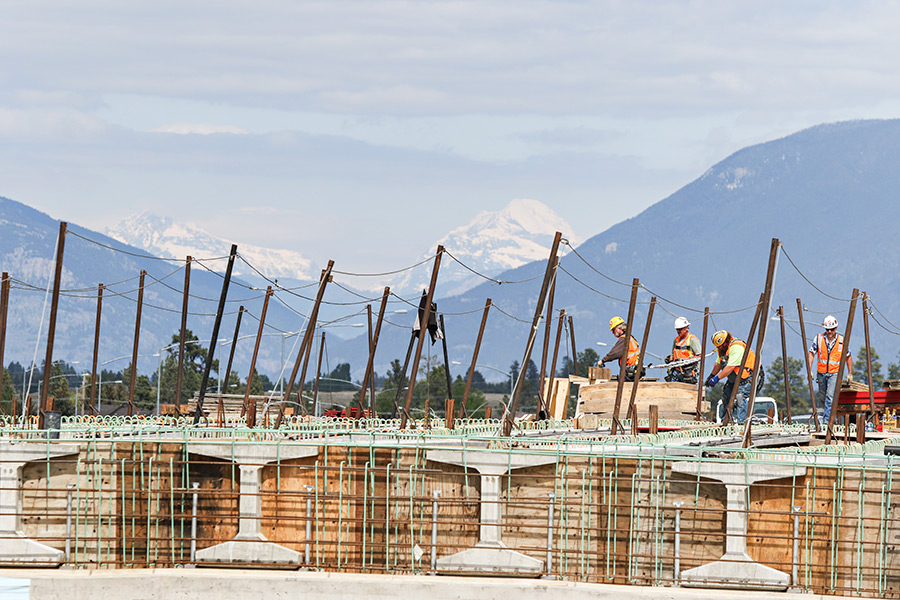It’s a new election year, but voters might get a feeling of déjà vu now that the governor has released a new plan to tackle the infrastructure needs throughout the state.
These needs, and the funding to take care of them, seem to be likely candidates for another major issue in the 2017 Legislature, which begins in January.
At the end of April, Gov. Steve Bullock, a Democrat, introduced his new $200 million plan for infrastructure improvement throughout the state. These bills in particular have become bones of contention at the last two legislative sessions – in 2013, Bullock vetoed a bill that would have created a new $35 million fund for improvements on water and road systems in oil-boom towns.
In 2015, lawmakers in Helena stuck around an extra few days to debate Senate Bill 416, a bipartisan public works bill that needed at least $150 million in funding. That bill would have authorized bonding and borrowing authority to finance the projects, but several Republican lawmakers took issue with the bill’s focus.
Rep. Keith Regier, R-Kalispell, was the House Majority Leader during the 2015 session, and spearheaded the successful effort to reject the bill, along with a core group of conservative Republicans, many from the Flathead, who splintered from their more moderate colleagues on the issue. Regier currently represents House District 4, but has reached his term limits. Instead of the House seat, Regier is running for Senate District 3.
The seat is open, since the current Sen. Bruce Tutvedt, R-Kalispell, can’t run again due to term limits.
The Democrats have their candidate for the Senate district, which encompasses land northwest of Kalispell, including West Valley, Whitefish, and Olney, in Melissa Hartman of Whitefish, who ran unopposed in the primary.
On the GOP side, Regier faces a challenge from political newcomer Don Kaltschmidt, well known throughout the valley as the owner of Don K Chevrolet Subaru, one of the valley’s leading auto dealerships.
Approaching the race for the Senate seat, both Regier and Kaltschmidt have said the infrastructure needs throughout the state need to be dealt with, but both are wary of Bullock’s new proposal.
Bullock, who is also up for re-election, hasn’t released many details about the $200 million plan. The so-called “Build Montana Trust” would use 75 percent of the revenue from the state’s coal severance tax fund and fund infrastructure needs in the future.
In an interview last week, Regier said he doesn’t oppose upgrading the state’s infrastructure but did take issue with the governor’s previous priorities when it came to doing so.
The 2015 bill would have funded a new building for the Montana Historical Society, as well as a new gymnasium at Montana State University, which Regier said were pet projects, while trying to maintain a $300 million budget surplus.
“To me, it was very frustrating that the priorities were not truly infrastructure projects,” he said. “I’m looking at next session having an infrastructure bill that would divide the state into four sections and divide surplus money in those four sections.”
Equally funding communities throughout the state could allay the classic battles of East versus West in the Legislature (lawmakers from eastern districts have accused the state of ignoring the needs of the communities there while taking advantage of the oil and gas money coming from their region), as well as the GOP versus Democrat divide.
“I think it would mitigate any kind of pushback when each part of the state would be getting the same amount of funds and their needs would be met,” Regier said.
Regier said he would be pleased to carry such a bill if elected.
Kaltschmidt said the infrastructure bill debacle from the 2015 session is what spurred him to file for the Senate seat. Party infighting and partisan politics have likely ended up costing the state money, he said.
“It’s something that two years ago would have cost a dollar instead of a$1.10 now,” Kaltschmidt said. “If we keep kicking the can down the road it just costs more and more money.”
According to the Montana Department of Transportation, District 1, which encompasses Missoula and the northwest corner of the state, has more than $262 million in backlogged projects not receiving funding, and a whole list of projects that aren’t even on the state’s radar due to the lack of funding. The American Society of Civil Engineers gave Montana’s infrastructure an overall grading of C- in 2014, meaning the poor end of mediocre.
In Flathead County alone, there’s a backlog of more than $71 million worth of MDT projects.
“You can really see the need. I know the whole state’s that way. It just frustrates me that our leaders in our state can’t come together on something as important as this,” Kaltschmidt said.
Jayson Peters, chairman of the Flathead County Republican Party, said infrastructure isn’t a partisan topic, but the difference between the parties lies in the ideological view of how to pay for those projects and which ones should be selected.
“If a clean, straightforward infrastructure bill comes before the next Legislature, any of our Flathead Republican candidates would support it with the condition that it was paid with surplus tax revenues,” Peters wrote in an email to the Beacon.
Regier agreed, saying that whoever is elected to the Legislature will be faced with a need to fund the projects deemed “necessary.”
“From my perspective, Republicans would like to see some money go to infrastructure, but let’s get the priorities right,” Regier said. “If they are projects that seriously need to get done, I think some borrowing could come into play there.”
